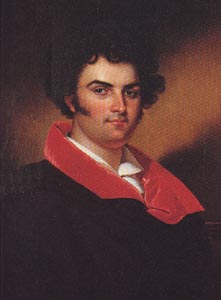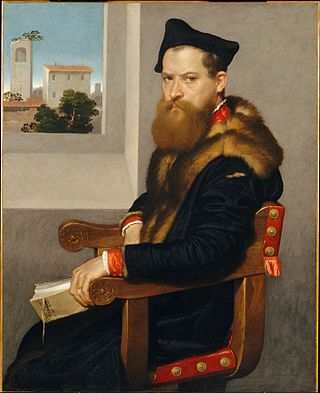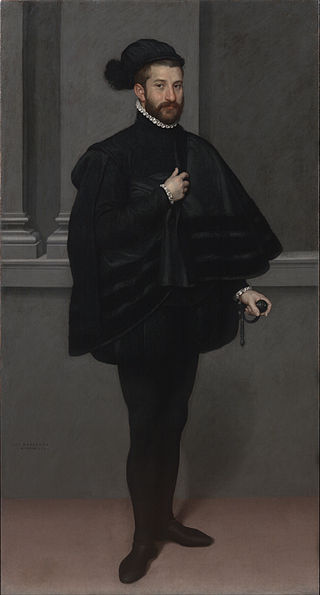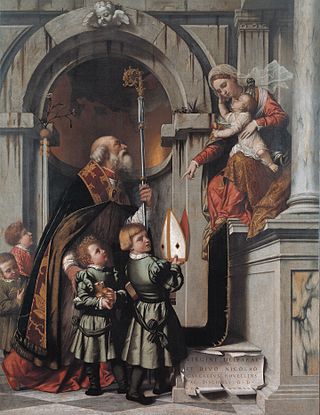Related Research Articles

Giovanni Battista Moroni was an Italian painter of the Mannerism. He also is called Giambattista Moroni. Best known for his elegantly realistic portraits of the local nobility and clergy, he is considered one of the great portrait painters of the Cinquecento.
The Salimbeni Prize is awarded by the Fondazione Salimbeni per le Arti Figurative of San Severino Marche to honour excellence in the writing of art history on an Italian subject. The Premio Salimbeni was established in 1983.

Giovanni Battista Rubini was an Italian tenor, as famous in his time as Enrico Caruso in a later day. His ringing and expressive coloratura dexterity in the highest register of his voice, the tenorino, inspired the writing of operatic roles which today are almost impossible to cast. As a singer Rubini was the major early exponent of the Romantic style of the bel canto era of Vincenzo Bellini and Gaetano Donizetti.

The Duomo of Monza, often known in English as Monza Cathedral, is the main religious building of Monza, Italy. Unlike most duomi, it is not in fact a cathedral, as Monza has always been part of the Diocese of Milan, but is in the charge of an archpriest who has the right to certain episcopal vestments including the mitre and the ring. The church is also known as the Basilica of San Giovanni Battista from its dedication to John the Baptist.

The Tailor is an oil on canvas painting by Italian painter Giovanni Battista Moroni, from 1565-1570. It is a portrait of a member of the Marinoni family, who has been traditionally taken to be a tailor practising his art during the work day. The painting is held in the National Gallery, in London.

Alik Cavaliere (1926–1998) was an Italian sculptor. He spent his life researching the meaning of life, freedom, nature, and history. An atheist and libertarian, he didn't believe in any preconceived, final structure of society, the environment, or the universe. Nor did he follow any art movements of his time, although he knew all of them and was temporarily influenced by some. He made his own way, narrating his perceptions with witty irony, through sculptures made up of a wide range of materials, disposed in a chaotic labyrinth which visitors are forced to traverse without being able to find a definitive point of view.

The Portrait of Bartolomeo Bonghi is an oil on canvas portrait by Italian artist Giovanni Battista Moroni, created in 1553. It is held at the Metropolitan Museum of Art, in New York. It depicts Bartolomeo Bonghi, a 16th-century Italian legal scholar. The portrait presents its subject as he was in life; a man of wealth and status. The buildings seen in the top left-hand corner of the painting identify the site of the portrait's sitting as Bergamo in Lombardy.

Holy Trinity is an oil-on-canvas painting by Lorenzo Lotto, created c. 1519–1520. It was produced as an altarpiece for the high altar of Trinità Church in Bergamo, then sited in front of the Church of Santo Spirito.

The Museo Adriano Bernareggi, also called the Museo Diocesano Bernareggi is a gallery of sacred art and objects housed in a former aristocratic palace, the Palazzo Bassi-Rathgeb, located on Via Pignolo #76 in Bergamo, Italy. The museum is presently managed by the Fondazione Adriano Bernareggi in conjunction with the Università degli Studi di Bergamo, and displays eclectic works of art from the 15th-century to present, often paired, and derived mainly from the Bernareggi family, as well as the Diocese of Bergamo.

The Knight in Black is an oil on canvas portrait painting of an unknown male subject by Giovanni Battista Moroni, from c. 1567. It is held in the Museo Poldi Pezzoli, in Milan.

The Deaf-Mute Filippo Viotti's Vision of the Virgin Mary is an oil on canvas painting by Moretto da Brescia, executed c. 1534, displayed in the Santuario della Madonna at Paitone in the Province of Brescia, Italy. It is first recorded in 1648 by Carlo Ridolfi, who wrote that "in the church atop Monte Paitone one can still admire a miraculous image of the Virgin which Moretto made at the request of that town for such a miracle".

The Rovelli Altarpiece is a 1539 oil on canvas painting by Moretto da Brescia, which since 1899 has been in the Pinacoteca Tosio Martinengo in Brescia, Italy. Strongly influenced by Titian, it is named after the schoolmaster Galeazzo Rovelli who commissioned it for the church of Santa Maria dei Miracoli in Brescia in 1539, where it remained until being removed in the 19th century and replaced by a copy. Its composition was reused by Moroni in his Mystic Marriage of Saint Catherine in the 1560s.

Mystic Marriage of Saint Catherine or Mystic Betrothal of Saint Catherine is a 1567-1570 oil on panel painting by Giovanni Battista Moroni, produced for the side-altar of Catherine of Alexandria in the church of San Bartolomeo, parish church of Almenno San Bartolomeo, where it still hangs. It is signed at lower right IO:BAP.MORONUS.P. The church had been begun in 1520 through the will of Giorgio Rota, but work lapsed until restarting in 1562. The painting draws on the composition of Moretti's 1539 Rovelli Altarpiece.

Count Guglielmo Lochis was an Italian nobleman, politician, art collector and art connoisseur.
Cesare Alpini is an Italian art historian. Born in Crema, Lombardy, he specialises in art from that city and Lombardy more widely. He is most notable for his contributions to scholarship on Giovanni Battista Lucini and Gian Giacomo Barbelli. He has collaborated on several art exhibitions held in Crema, including Pittura sacra a Crema dal '400 al '700 (1992), L'estro e la realtà (1997), Officina Veneziana (2002) and Luigi Manini (2007).
Agostino Lampugnani was an Italian Benedictine monk and Baroque writer.

The Portrait of Alessandro Vittoria is an oil on canvas painting created by Italian painter Giovanni Battista Moroni, in 1551–1552. It is held at the Kunsthistorisches Museum, in Vienna.

The Portrait of a Man Holding a Letter, also known as The Lawyer, is an oil on canvas painting by Italian painter Giovanni Battista Moroni, from 1570-1572. It is held at the National Gallery, in London. It is considered one of the most representative paintings of the artist's maturity.

Portrait of a Lady, also known as The Lady in Red is an oil on canvas painting by Italian painter Giovanni Battista Moroni, from c. 1556–1560. It is believed to depict Countess Lucia Albani Avogadro, a 16th-century Italian poet. It is held in the National Gallery, in London.

The Knight in Pink is an oil on canvas painting by Italian painter Giovanni Battista Moroni, from 1560. It depicts a nobleman, Gian Gerolamo Grumelli, and is one of the artist's best-known portraits. It is held in the Palazzo Moroni, in Bergamo.
References
- ↑ SIMONE FACCHINETTI Storie e segreti del mercato dell’arte, Il punto Franciacorta. .
- ↑ "Fondazione Adriano Bernareggi" (in Italian).